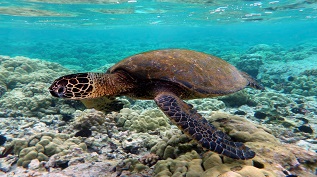The Question of Our Impact in 2022

Editor’s Note: This blog post originally appeared here.
A few weeks ago, I described how our “Outcome Action Plan” mechanism works to our Board. I was asked to explain how we are going to monitor the implementation of our projects, now that they are all aligned with the objectives to be attained by 2022 (see my previous blog entry). However, since we started this last strategic cycle, there is one question that keeps on cropping up, and it obviously arose during my presentation: how are we going to measure our impact in 2022?
Good question. Around fifteen years ago, when I was in charge of a small marine reserve off the coast of French Guiana, my priority was to protect the only seabird breeding island between the Caribbean and Latin America. Each year, whilst I was using a brush cutter to rid the island of invasive plants (which we had no doubt brought there ourselves, but that’s another story), I would count in my head the number of terns that were nesting in the places I was clearing. With one circular movement of my arm, 10 tern nests were saved. Three days of teamwork protected 10,000 nests and ensured connectivity between Brazilian and Caribbean bird populations. I could measure the impact of my intervention with my outstretched hand.
Today, I no longer clear the undergrowth on desert islands (although I sometimes think it would do me good), and MAVA’s interventions take place several steps upstream from direct action. And this distance from field action complicates our relationship with its impact. The further we move away from the local level, the more difficult it is to link our financial commitment to measurable change. Measuring the actions of a foundation is a huge challenge. And since the MAVA Foundation loves challenges, we decided that we really had to get to the bottom of this issue!
When we developed our most recent strategic cycle 2016-2022, we took an initial decision: in 2022, we are going to measure our impact on the threats affecting biodiversity, rather than on biodiversity itself. Let me explain. Let’s take species such as sea turtles. They swallow plastic, they are accidentally caught (by-catch) by trawlers, they are disoriented by the lights in coastal towns at night, and face lots of other problems too. Naturally, we want to improve the conservation status of sea turtles. However, it is very ambitious to aim to achieve a measurable change in sea turtle populations by 2022. Turtles have long lives and action taken today will no doubt take effect in many years’ time. It will also be very hard to attribute specific changes directly to our actions.
So, it is difficult to measure our impact on sea turtle populations directly… Therefore, why not measure a step above our target, by studying the human activities that affect the turtles? For example, why not measure our impact on sea turtle by-catch by fishing boats? Or rather boats that will no longer catch them, thanks to our action. That is a realistic and measurable challenge. In 2022, we shall be able to evaluate the decrease in the number of turtles captured thanks to the projects we support, knowing that this reduction will certainly have an impact on the turtle populations, but well after 2022.
Therefore, we have drawn up our action plans based on different objectives for reducing threats. This is a first step towards responding to this impact issue. However, the key components of our impact cannot be confined to the results of actions carried out by our partners in the field (these are also, and above all, the results of their work, aren’t they?). We finance conservation projects, but we also support the partners who carry them out.If sea turtles are no longer caught by fishing boats, it is because there are teams of researchers who have developed suitable methods. It is thanks to the efforts of conservation NGOs, working to raise people’s awareness and draw attention to different issues. This change has come about thanks to a community of partners who share the same commitment. We are also focused on strengthening our partners, helping them to mobilise new funding and to develop their networks, as well as creating space for the younger generation and for innovation. Many ongoing projects which we will also be assessing.
In the end, assessing our impact on both project and partner level is a faithful reflection of our mission: We conserve biodiversity for the benefit of people and nature by funding, mobilising and strengthening our partners and the conservation community. But that is not all. One important element remains regarding the Foundation’s impact, which could be studied. Our work is also deeply affected by our founder’s values. How could we measure the impact of Luc Hoffmann and his family’s philosophy on the world of conservation? That is yet another challenge…
